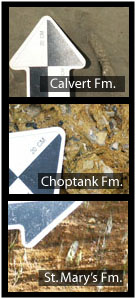Calvert Rock Formations:
There are three major units of rock that can be
observed in Calvert
County Maryland. These rocks are grouped into three major
intervals that record changes in sea level.
 The
Calvert Formation:
The
Calvert Formation:
The oldest sediments deposited in the Salisbury Embayment are grouped
into a package of sediment known as the Calvert Formation. The
Calvert is made up of three distinct marine units, each differing
from the others in the nature of the sediment composition and fossil
fauna. The Calvert Fm. sediments consist of thick clay beds with thin
sand
layers, which were deposited over a 10 million year period of
time. The Calvert Formation is named after the location (Calvert
County) where they were firstdescribed (Click
for Photo).
The Choptank Formation:
Following a significant drop in sea level in the
Salisbury Embayment, the
clays that make up the Calvert Formation give way to marine sands,
which
form the Choptank Formation. This formation is named for the Choptank
River, where exposures of this formation are found. The Choptank
was deposited 13 to 12 million years ago. Sediments in the
Choptank are made up of yellow sand and green-grey colored sandy clay (Click for Photo).
The St. Mary's Formation:
The St. Mary's Formation is named for St. Mary's
County, where the
original deposits were observed. The St. Mary's Formation
consists of blue-colored
sandy clay that grades into coarse sand. This
change from clay to sand indicates a significant drop in sea
level during the deposition of the St. Mary's Fm, 12 to 10
million years ago (Click for Photo).
 The
Calvert Formation:
The
Calvert Formation: